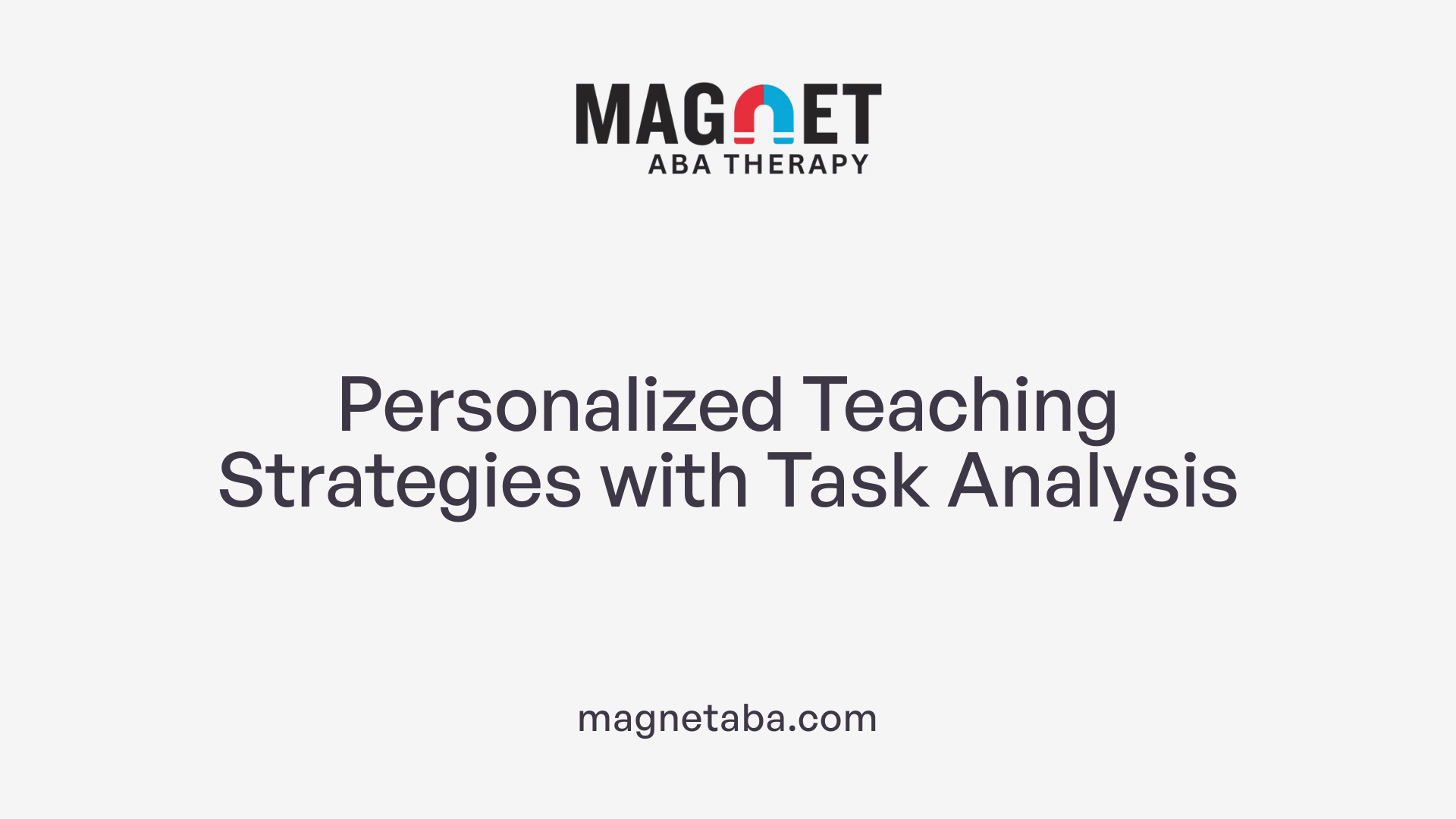Unpacking Social Context in Autism Support
Understanding and interpreting social context clues is a crucial skill that children with autism spectrum disorder (ASD) often find challenging. Applied Behavior Analysis (ABA) therapy offers structured and evidence-based methods to teach these essential social cues through individualized, systematic interventions. This article explores how ABA techniques can be employed effectively to teach context clues in social settings, supporting social skills development and independence for individuals with autism.
What is Applied Behavior Analysis (ABA) and Its Role in Autism Support?

What is Applied Behavior Analysis (ABA) therapy, and how is it used to support individuals with autism?
Applied Behavior Analysis (ABA) is a science-based approach focused on understanding and improving behavior. It uses strategies like positive reinforcement to encourage helpful behaviors such as communication, social skills, and daily living activities. Simultaneously, it aims to reduce harmful or problematic behaviors. ABA programs are carefully individualized, designed by professionals like Board-Certified Behavior Analysts (BCBAs) to address each person's unique needs.
How is ABA therapy tailored through individualized treatment planning?
Each ABA program starts with a thorough assessment of the individual's current skills and goals. This evaluation helps create a personalized treatment plan that breaks down complex behaviors into manageable steps. Techniques such as Discrete Trial Training (DTT) and Natural Environment Teaching (NET) are often combined to provide both structured learning and flexible, real-world practice. This customization ensures therapy matches the learner's development and interests for the most effective progress.
In what settings is ABA therapy typically delivered?
ABA therapy is versatile and delivered in multiple environments, including the home, school, and community. This variety helps promote skill generalization across different situations. Structured settings like the classroom provide consistency, while natural environments encourage practical application. Caregiver involvement is also essential, with family members trained in ABA techniques to reinforce learning beyond therapy sessions.
What is the overall aim of ABA for fostering independence?
The primary goal of ABA is to equip individuals with autism with fundamental skills that promote independent living. By focusing on socially important behaviors and daily living skills—such as personal hygiene, communication, and social interaction—ABA supports greater autonomy. Through consistent, individualized instruction and real-life practice, ABA therapy helps participants become active, engaged members of their communities.
The Importance of Task Analysis in Teaching Social Context Clues
What is Task Analysis and Its Purpose?
Task analysis is a teaching method used primarily in applied behavior analysis (ABA) to help children with autism spectrum disorder (ASD) learn complex skills by breaking them down into simple, manageable steps. This approach ensures that each part of a skill is taught systematically and clearly, making it easier for learners to grasp new concepts. In the context of social skills, task analysis helps by focusing on individual components of social interactions that may seem overwhelming or confusing.
How Does Task Analysis Break Down Complex Social Skills?
Social skills often involve subtle cues and multi-step behaviors such as recognizing who someone is, understanding social roles, or responding appropriately in conversations. Task analysis simplifies these by dividing them into sequential steps. For example, teaching children to identify "Who" questions in conversations can be broken down into recognizing faces, relating names to people, and practicing responses through role-playing or visual cues. Techniques like chaining—both forward and backward—and modeling support this step-by-step learning process.
How is Task Analysis Linked to Social Learning?
By applying task analysis, instructors and caregivers can systematically teach social context clues that are vital for effective communication and relationship building. Visual supports, consistent routines, and individualized instruction enhance understanding and retention of social information. This targeted approach replaces confusion or problem behaviors with appropriate skills, promoting generalization of learned social cues beyond the classroom. Ultimately, task analysis serves as a foundation for developing independent social functioning in children with ASD.
Techniques Within Task Analysis: Chaining, Modeling, and Discrete Trial Instruction
What is Forward and Backward Chaining?
Forward and backward chaining are sequential teaching methods used to break down complex skills into smaller steps. In forward chaining, instruction begins with the first step of a task and proceeds step-by-step until the entire sequence is mastered. For example, when teaching handwashing, the child first learns to turn on the faucet before progressing to subsequent steps.
Conversely, backward chaining starts with the last step of the task and moves backward. This approach allows the child to experience the completed task early, which can boost motivation. For instance, the child may first learn to dry hands before practicing earlier steps like rinsing.
How Does Modeling Support Learning?
Modeling involves demonstrating a behavior or skill for the learner to imitate. It serves as a visual example, helping children with ASD understand what is expected. Behavioral health professionals and caregivers show the task being performed correctly, which the child then practices. Modeling is especially helpful for teaching social skills and daily routines, as it provides a clear standard for the child to emulate.
What is Discrete Trial Instruction (DTT) and How is it Used?
Discrete Trial Instruction (DTT) is a highly structured teaching technique that presents skills as distinct, manageable trials. Each trial includes a prompt, the child's response, and a reinforcement or correction. DTT breaks down learning into clear steps paired with immediate feedback, repetition, and rewards. This method is effective for acquiring new skills and is commonly employed in ABA therapy.
DTT's structured approach offers a consistent learning environment, beneficial for children who thrive on routine and clarity. When combined with forward and backward chaining, it helps master both component skills and the entire task sequence.
What is the Scientific Basis of These Techniques?
These task analysis methods are rooted in the principles of learning theory and supported by empirical research. Studies demonstrate their effectiveness in improving socially important behaviors and fostering independence in children with ASD. By using systematic instruction, positive reinforcement, and individualized plans, chaining, modeling, and DTT facilitate skill acquisition and generalization.
The evidence-based nature of these techniques makes them foundational in ABA therapy, with practitioners tailoring interventions based on ongoing assessment to meet each child's unique needs.
Discrete Trial Training (DTT): Structured Learning for Contextual Understanding

What is Discrete Trial Training (DTT)?
Discrete Trial Training (DTT) is a highly structured teaching method used in Applied Behavior Analysis (ABA) therapy to support children with autism spectrum disorder (ASD). It involves breaking down complex skills into small, clear, and manageable steps, which are taught one at a time.
How Does DTT Break Skills Into Steps?
In DTT, each skill is segmented into discrete tasks. During teaching, clear prompts guide the child’s response, and each step is followed by immediate feedback or reinforcement. This systematic approach helps the child master each component before moving on to the next.
Mastering Social Context Clues through DTT
DTT is especially effective for teaching understanding of social context clues. By isolating specific social behaviors and practicing them repeatedly, children learn to recognize cues like facial expressions, tone, and social questions such as "Who?" This focused instruction builds the foundation for better social interaction.
Role of Repetition and Reinforcement
The repetition inherent in DTT helps reinforce learning by providing consistent practice opportunities. Positive reinforcement—such as praise, tokens, or preferred activities—is delivered immediately after correct responses, strengthening the desired behavior and motivating continued effort.
By using these structured steps and reinforcement strategies, DTT offers a clear, consistent way for children with ASD to acquire important social and functional skills.
Natural Environment Teaching (NET): Generalizing Social Skills in Real-Life Contexts
What Is Natural Environment Teaching (NET)?
Natural Environment Teaching (NET) is an applied behavior analysis (ABA) strategy that focuses on teaching skills through everyday life activities rather than in structured sessions alone. It uses real-world situations to encourage learning and skill use in natural contexts.
How Does Teaching in Everyday Situations Work?
In NET, learning happens during routine interactions and activities that a child encounters daily. This could include playing with toys, meal times, or community outings. By integrating teaching moments into these natural settings, children with ASD can practice skills as they arise naturally, increasing the chances they’ll apply the skills independently.
What Are Natural Reinforcers and How Are They Used?
Natural reinforcers are rewards that are directly connected to the activity or skill being taught. For example, if a child asks for a toy, receiving that toy acts as a reinforcer. NET utilizes these natural consequences to motivate and engage children effectively, making learning more meaningful and relevant.
Benefits for Generalizing Social Skills
NET helps children generalize social skills beyond the therapy setting. Because skills are taught in real-life environments, children are better able to use communication, social interactions, and problem-solving skills across various contexts. This practical application supports greater functional independence and social engagement.
This approach, often combined with Discrete Trial Training (DTT), ensures that children benefit from both structured learning and flexible, natural practice of skills tailored to their individual needs.
Balancing Structure and Flexibility: Combining DTT and NET in ABA Programs

How Does Discrete Trial Training (DTT) Provide Structure?
Discrete Trial Training (DTT) is a highly structured teaching method used in Applied Behavior Analysis (ABA) therapy. It breaks down skills into small, manageable steps with clear prompts, repetition, and reinforcement. This systematic approach allows for targeted learning and mastery of specific behaviors. The clear sequence and consistency within DTT help children with autism to focus on and acquire foundational skills efficiently.
How Does Natural Environment Teaching (NET) Promote Skill Generalization?
Natural Environment Teaching (NET) emphasizes learning in everyday situations using natural reinforcers. By embedding teaching moments within typical daily routines and social interactions, NET helps children generalize skills across settings. This flexibility supports the transfer of learned behaviors from the therapy setting to real-life contexts, which is essential for functional independence and social engagement.
How Are ABA Plans Tailored to Individual Needs?
ABA programs use assessments of individual skills and goals to customize interventions. DTT offers structure suited for teaching precise skills systematically, often ideal for initial learning stages. NET, with its adaptable format, enhances the applicability of those skills in natural settings. Combining both methods ensures that therapy aligns with the unique developmental profile and preferences of each child, maximizing learning outcomes.
What Are the Benefits of Integrating Both Approaches?
Integrating DTT and NET leverages the strengths of each: DTT’s precise, repetitive instruction supports skill acquisition, while NET's naturalistic strategies promote generalization and practical use. This blend fosters consistent learning, reduces problem behaviors by teaching appropriate alternatives, and enhances communication and social skills. The combination creates more effective and comprehensive ABA treatment plans tailored to a child's evolving needs.
Using Visual Supports to Reinforce Understanding of Social 'Who' Questions

What types of visual supports are commonly used in ABA therapy?
Visual supports are essential tools in Applied Behavior Analysis (ABA) therapy for children with Autism Spectrum Disorder (ASD). Common types include picture cards, visual schedules, and cue cards. Picture cards depict people or activities to clarify concepts, visual schedules outline sequences of events or tasks, and cue cards provide prompts to guide expected responses.
How do visual supports aid in teaching 'Who' questions?
Teaching 'Who' questions focuses on enhancing a child's ability to recognize and understand social relationships, which are crucial for their social development. Visual supports make these abstract ideas more concrete. For example, picture cards showing family members or peers can help children identify "who" is involved in a particular situation. This supports comprehension by linking images to language and social context.
What is the role of visual tools in ASD learning?
Visual tools provide consistent, individualized, and systematic instruction that matches the learning preferences of many children with ASD. By breaking down tasks and social information visually, these supports reduce confusion and promote engagement. They also help generalize skills across environments by offering clear and predictable cues that children can rely on in classrooms, homes, and other settings.
In summary, visual supports like picture cards, schedules, and cue cards are integral to teaching 'Who' questions. These tools enhance social comprehension by making social relationships easier to understand and respond to. Their use in ABA therapy enriches the learning experience, enabling children with ASD to build essential social skills needed for daily interactions.
Incorporating Role-Playing and Natural Conversations to Develop Social Awareness

Role-Playing to Practice Social Interactions
Role-playing is an effective ABA technique that allows children with autism spectrum disorder (ASD) to practice and improve social interactions in a controlled, supportive environment. By simulating real-life social scenarios, children learn how to respond appropriately, understand social cues, and build confidence in their communication skills.
Structured and Natural Conversation Methods
Combining structured practice with natural conversations enhances social learning. Structured practice, such as scripted role-plays or guided dialogues, provides clarity and repetition, helping children grasp specific social skills. Natural conversations—occurring spontaneously during daily activities—offer opportunities to apply these skills in meaningful contexts. This blend ensures children are prepared for real-world social engagement and can generalize their learning across settings.
Teaching Recognition of Social Relationships and Context
A core component of social awareness is understanding 'Who' questions, which help children recognize relationships and social roles. ABA therapy incorporates role-playing and natural dialogues to teach children to identify people’s roles (e.g., family members, teachers, peers) and adapt their communication accordingly. Caregiver involvement often supplements these methods, reinforcing learning through routines and modeling at home, thereby deepening the child's comprehension of social context.
Caregiver Involvement: Essential Partners in Teaching Context Clues
Training Caregivers on ABA Techniques Like Modeling and Reinforcement
Caregivers play a vital role in the success of Applied Behavior Analysis (ABA) therapy for children with autism. Training parents and guardians in ABA strategies such as modeling and reinforcement empowers them to support their child’s learning consistently. Modeling involves demonstrating desired behaviors, while reinforcement strengthens positive behaviors by providing rewards or praise. This hands-on training enables caregivers to become active participants in the child’s skill development.
Consistency in Practice
Consistency is essential for making ABA strategies effective. When caregivers apply learned techniques regularly at home, it reinforces the skills taught during therapy sessions. A consistent routine using visual supports, schedules, and structured prompts helps the child better understand social relationships and context clues. This approach helps the child generalize the skills from the clinical environment into everyday life.
Generalization of Skills Beyond Clinical Settings
Ensuring that skills learned in therapy transfer to real-world situations depends heavily on caregiver involvement. By practicing 'Who' questions through role-playing and natural conversations, caregivers help children recognize social cues outside the therapeutic setting. This ongoing practice promotes independence and social competence, supporting the child’s ability to navigate various environments successfully.
Early Intervention and Tailored Strategies for Language and Social Engagement
Why is early intervention important for children with ASD?
Early intervention plays a crucial role in helping children with autism spectrum disorder (ASD) develop essential language and social skills. Research shows that introducing applied behavior analysis (ABA) strategies at a young age can significantly improve outcomes in communication and social engagement. Early teaching addresses challenges like language processing difficulties and reduced reward system activation, providing a strong foundation for future learning.
How do targeted ABA methods enhance language acquisition?
ABA incorporates structured techniques such as Discrete Trial Training (DTT) and Natural Environment Teaching (NET) to improve language skills. DTT breaks down language tasks into teachable steps with clear prompts and consistent reinforcement, while NET encourages learning through everyday social interactions and natural rewards. Both methods are individualized to the child's needs, ensuring progress in language development through structured and flexible approaches.
In what ways can tailored teaching improve social engagement?
Tailored ABA interventions promote social engagement by teaching children to recognize social relationships using strategies like role-playing, natural conversations, and visual supports. Programs focusing on 'Who' questions enhance understanding of social roles and foster communication skills. Caregiver involvement in applying these strategies consistently across home and community settings further reinforces social learning and helps generalize skills beyond therapy sessions.
Addressing Challenges: Language Processing and Motivation in ASD
Understanding Difficulties with Language Processing
Children with autism spectrum disorder (ASD) often face unique challenges in processing language, which can impact their communication and learning. These difficulties may include delays in understanding spoken words, challenges in following multi-step directions, and trouble grasping the subtleties of social language. Recognizing these hurdles is essential for designing effective teaching methods tailored to each child's needs.
Reduced Reward System Activation
Another common barrier for children with ASD is a reduced activation of the brain's reward system. This means that typical social interactions or learning activities might not naturally motivate these children as they do typically developing peers. As a result, motivating children with ASD requires inventive strategies that align with their individual interests and preferences.
Developing Tailored Teaching Approaches to Overcome Barriers
Applied Behavior Analysis (ABA) therapy addresses these challenges through personalized interventions. Techniques such as Discrete Trial Training (DTT) offer structured teaching with clear prompts and consistent reinforcement, helping to break down complex skills into manageable parts. Meanwhile, Natural Environment Teaching (NET) uses real-life settings and natural rewards to enhance motivation and generalize skills across environments.
Moreover, visual supports like schedules and cue cards assist children in understanding language and routines, while caregiver involvement ensures consistent application of these strategies beyond therapy sessions. By combining structured instruction with naturalistic teaching and tailoring approaches to individual processing and motivational profiles, ABA therapy effectively supports language acquisition and communication in children with ASD.
Systematic, Individualized Instruction: Keys to Successful Teaching with Task Analysis

Why is consistency important in teaching children with ASD?
Consistency is crucial in teaching children with autism spectrum disorder (ASD) as it establishes clear expectations and predictable routines. This helps reduce anxiety and facilitates learning by reinforcing behaviors through repeated practice. Using consistent methods and schedules increases the likelihood that children will master skills effectively.
How is individualization of programs implemented in ABA therapy?
Individualization involves tailoring task analysis and ABA interventions to meet each child's unique skills, needs, and goals. Behavioral health professionals assess baseline abilities and design programs targeting specific areas such as daily living skills or communication. Personalized visual supports and customized teaching strategies ensure the child receives relevant, meaningful instruction.
What role does methodical instruction play in supporting learning?
Methodical instruction in ABA entails breaking complex tasks into smaller, manageable steps and teaching them in a systematic sequence. Techniques like discrete trial training (DTT) provide structured lessons with clear prompts and reinforcement. This step-by-step approach enhances comprehension and skill acquisition while promoting independence.
How is progress monitored and plans adjusted?
Professionals continually evaluate a child's response to interventions by tracking performance and behavior changes. Regular monitoring allows for timely modifications to instruction or goals to better align with the child's development. This adaptive process ensures that teaching remains effective, supporting ongoing growth and generalization of skills across different settings.
By combining consistency, individualized planning, systematic teaching, and ongoing monitoring, task analysis becomes a powerful tool for empowering children with ASD to develop essential abilities for independent living and social engagement.
Teaching Activities of Daily Living (ADLs) to Support Social Independence
How is task analysis used to teach ADLs like brushing teeth and hand washing?
Task analysis breaks down complex activities into simple, manageable steps, making it easier for children with autism to learn. When teaching activities of daily living (ADLs) such as brushing teeth and washing hands, task analysis applies techniques like chaining (both forward and backward), discrete trial instruction, and modeling. These step-by-step procedures ensure children master each component of the activity before moving on to the next, promoting skill acquisition with consistency and individualization.
Visual supports like schedules and cue cards frequently accompany task analysis instruction. These tools serve as reminders and prompts, guiding children through the steps and increasing their independence over time.
Why are foundational life skills important for individuals with autism?
The primary goal of applied behavior analysis (ABA), including task analysis, is to help individuals with autism spectrum disorder (ASD) develop fundamental skills necessary for independent living. Foundational life skills, such as proper hygiene routines, are essential for personal care and social acceptance.
Mastering ADLs builds confidence and reduces reliance on caregivers, fostering a sense of autonomy. These practical skills also serve as stepping stones towards more complex social interactions and responsibilities required in daily life.
How do ADLs relate to social independence and self-sufficiency?
Being able to independently perform activities like brushing teeth and washing hands significantly contributes to social independence. Proper hygiene affects social interactions and acceptance, impacting how individuals with autism connect with peers and participate in community settings.
Teaching ADLs through evidence-based methods like task analysis reinforces appropriate behaviors while replacing problem behaviors with positive skills. The structured yet flexible nature of this teaching supports generalization, enabling children to apply these skills across different environments, which is crucial for meaningful social independence and overall self-sufficiency.
Replacing Problem Behaviors and Reinforcing Positive Social Skills Through ABA
How is ABA used to reduce problematic behaviors in children with autism?
Applied Behavior Analysis (ABA) uses structured teaching methods to replace problem behaviors with appropriate, functional skills. By breaking down targeted behaviors into manageable tasks, therapists can systematically teach alternative responses that serve the same function as the problematic behavior. This approach directly addresses behavioral challenges and focuses on building positive skills through consistent reinforcement.
In what ways does ABA reinforce appropriate social behaviors?
ABA therapy emphasizes reinforcing positive social behaviors through strategies like modeling, role-playing, and reinforcement of correct responses. Techniques such as Discrete Trial Training (DTT) and Natural Environment Teaching (NET) provide both structure and real-life contexts to help children develop communication and social skills. Caregiver involvement in reinforcement strategies further strengthens these positive behaviors, encouraging improved interaction and social engagement.
How does ABA support transferring learned skills across different settings?
Generalization of skills outside the initial teaching context is crucial in ABA therapy. By using natural reinforcers in varied environments (through NET) and personalized visual supports like schedules and cue cards, ABA practitioners ensure children practice and apply learned behaviors consistently. This flexible approach allows skills, including social communication and daily living activities, to transfer effectively across home, school, and community settings, promoting independence and social competence.
Building Social Competence through Tailored ABA Strategies
Teaching context clues in social settings is fundamental for the social development of children with autism. Through Applied Behavior Analysis and its array of scientifically validated techniques—such as task analysis, Discrete Trial Training (DTT), and Natural Environment Teaching (NET)—therapists can create individualized, consistent programs that develop vital social understanding. Visual supports, caregiver involvement, and early intervention further enhance the acquisition and generalization of these skills. Ultimately, ABA therapy empowers individuals with ASD to interpret social contexts more effectively, fostering their independence and meaningful participation in everyday social environments.
References
- Task Analysis in ABA Therapy: Strategies and Examples
- 7 Effective Strategies for Teaching 'Who' Questions in ABA ...
- Learn What Are the Two Teaching Methods of ABA Today
- Applied Behavior Analysis (ABA)
- Applied Behavior Analysis (ABA)
- The Controversy Around ABA
- Treatment and Intervention for Autism Spectrum Disorder











